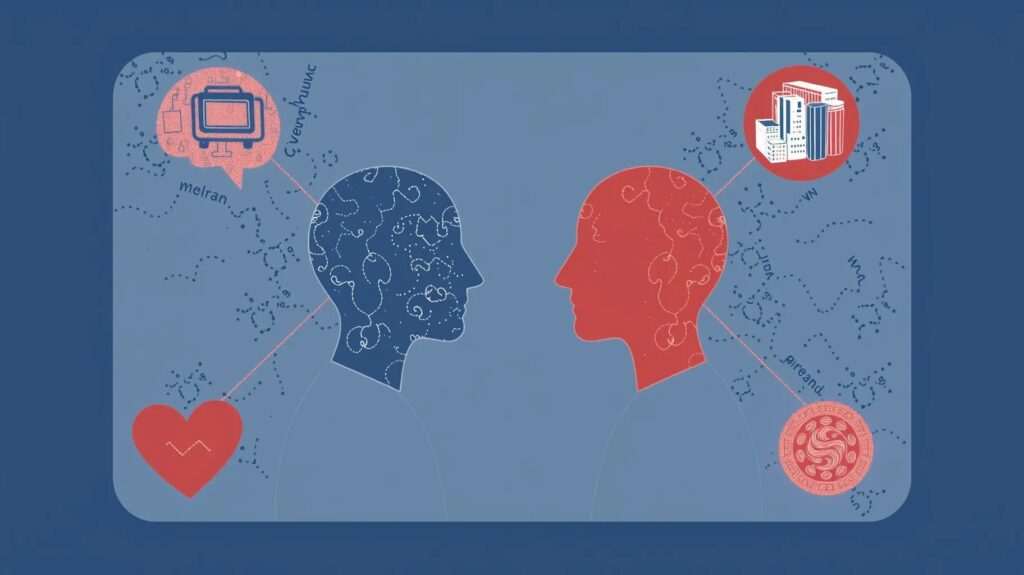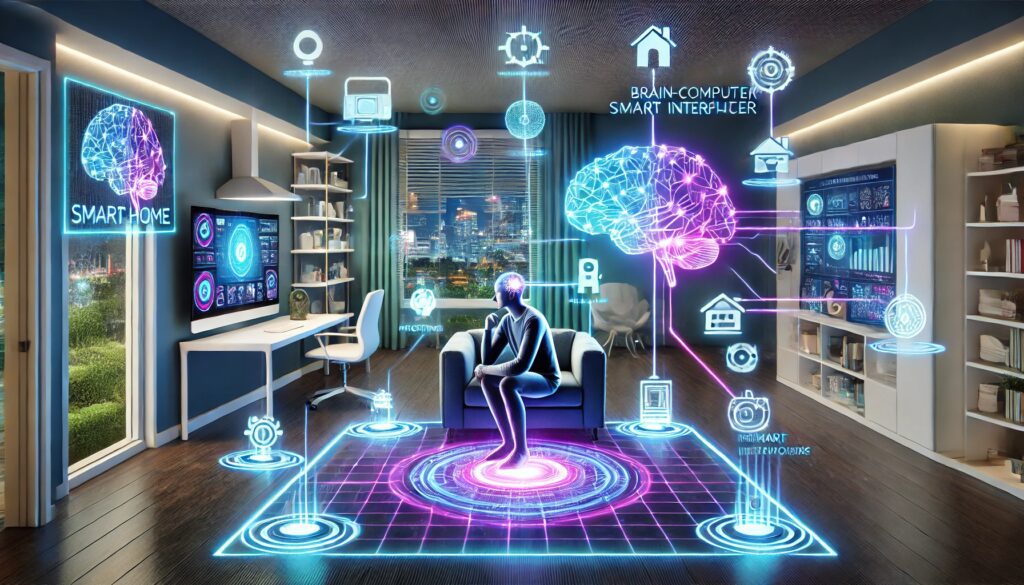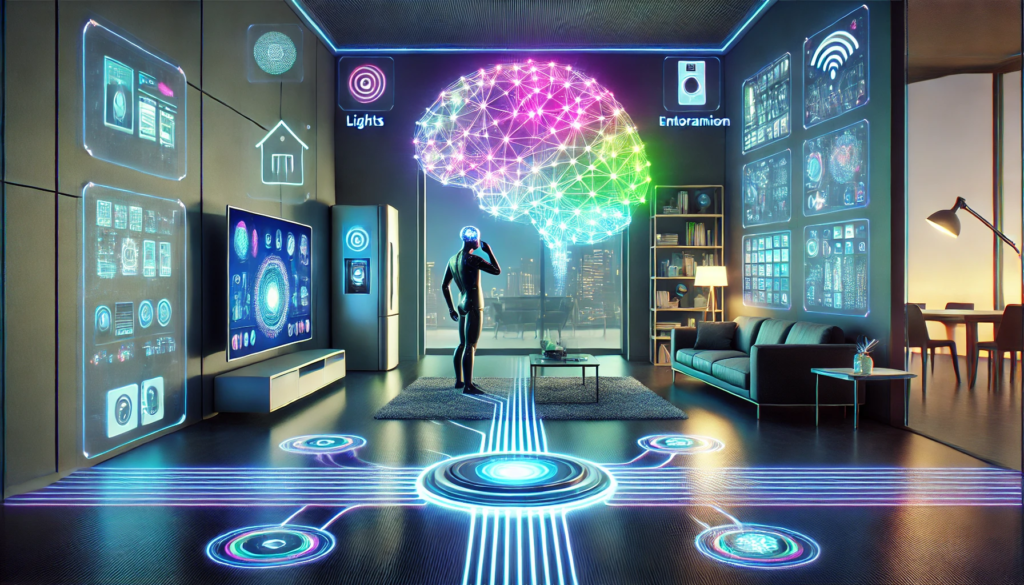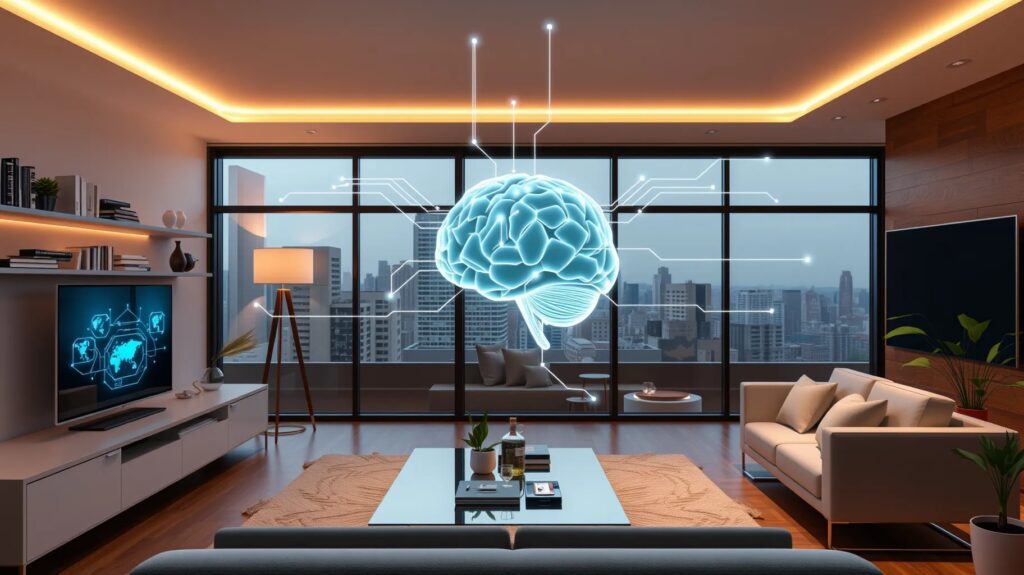
What Are BCIs and Why Are They a Game Changer?
Brain-Computer Interfaces (BCIs) are no longer the stuff of science fiction. These groundbreaking devices allow direct communication between the human brain and external systems, like computers or prosthetics.
Imagine this—controlling your smartphone, your TV, or even your thermostat with just a thought. Sounds futuristic, right? Well, BCIs are slowly making that possible, and tech enthusiasts are buzzing.
The integration of BCIs with the rapidly expanding Internet of Things (IoT) opens up a whole new world of possibilities. IoT is already reshaping how we interact with our homes, cars, and workplaces by connecting everyday devices to the internet.
But when BCIs come into play, you’re not just clicking a button or using a voice command anymore—you’re using pure thought.
This is why BCIs are a game changer. They elevate human-device interaction to a level we’ve never seen before.
The Growing Influence of IoT in Modern Homes
Let’s talk about smart homes. You’ve probably heard of them, right? These are homes equipped with IoT devices that allow you to control lights, locks, and appliances via a smartphone or smart assistant like Alexa. The IoT market is booming—by 2030, it’s predicted there will be over 50 billion connected devices globally. People are loving the convenience it brings, and it’s already becoming mainstream.
The thought of sitting on your couch and dimming your lights without lifting a finger—it’s the ultimate convenience, right? Now, combine that with the potential of BCIs, and we’re talking about a leap from convenience to an unbelievably futuristic experience. You’ll not even need to say, “Alexa, turn off the lights.” Your mind will do it for you. This is the power of BCIs integrated with IoT, and it’s why the combination is attracting attention from both consumers and industry giants.
How BCIs Are Bridging the Gap Between Mind and Machine
Now, let’s dive into the juicy part—how do BCIs actually work? The key lies in reading brain signals. Every time you think or move, your brain sends electrical impulses. BCIs pick up on these signals and translate them into commands that a machine can understand. Essentially, your brain is doing the talking, but instead of talking to another person, it’s talking to your devices.
BCIs have been used in medical applications for a while now—helping people with disabilities control prosthetic limbs or communicate through computers. However, bringing BCIs into the consumer space, particularly with IoT, is a whole new ball game. We’re talking about non-invasive BCIs that could be worn like a headband or hat, picking up brain activity and translating it into commands for connected devices. You wouldn’t even have to lift a finger, literally.
Real-World Applications of BCIs in Smart Homes
Imagine waking up in the morning and, without moving a muscle, your coffee starts brewing, the blinds open, and your favorite playlist starts playing—just because you thought about it. BCIs could bring this kind of luxury into reality, controlling smart home devices just by interpreting your mental cues.

Some companies are already experimenting with basic BCI applications in the smart home market. From adjusting your thermostat with thought alone to controlling security systems, the possibilities are staggering. BCIs would not only make controlling your home easier but could also make life more accessible for people with limited mobility. Total mind control of your environment? Now that’s living in the future.
The Role of Artificial Intelligence in BCI and IoT Integration
Artificial Intelligence (AI) is the silent partner in this revolution. AI is what makes sense of the complex signals your brain sends. Without it, BCIs would struggle to interpret thoughts accurately. Think of AI as the translator between your brain and your smart home. It learns your patterns, adapts to your preferences, and makes using BCIs with IoT smoother.
For instance, AI could help BCIs recognize the difference between you thinking about turning on the lights versus just imagining the action. It learns the nuances of your thought processes and adjusts accordingly. The smarter the AI, the better the brain-device interaction, making AI absolutely essential in creating seamless, reliable communication between your mind and the internet-connected world around you.
Breaking Down the Technology: How BCIs Work with IoT Devices
So, how exactly do BCIs interact with smart devices? Let’s get technical for a second—but not too deep. In essence, BCIs read your brain’s electrical signals. These signals, created by neurons firing off in different parts of the brain, are collected by sensors—typically placed on the scalp. This is known as a non-invasive BCI, which is key for consumer adoption. These brain signals are then processed by a machine learning algorithm that deciphers what action you want to take.
Once your intention is understood—like turning on the lights, adjusting the thermostat, or locking the doors—the BCI system sends this command to the relevant IoT device. Since most IoT systems operate through wireless protocols like Wi-Fi, Bluetooth, or Zigbee, the BCI acts as the remote control, bypassing any need for voice commands or physical inputs. It’s almost like your thoughts are speaking the device’s language, and the IoT system responds in real-time.
Future Possibilities: Brain-Controlled Appliances and Daily Life
The future of smart living could be one where you no longer reach for your phone to control a device. Instead, you could unlock your front door by thinking, “unlock.” Need to water your plants? Your mind could manage that too. You might not even need a dedicated app—everything could be controlled by a simple thought, making devices more intuitive and connected to your natural behavior.

We’re looking at a future where your appliances and home systems anticipate your needs based on your brain activity. For instance, a smart refrigerator that opens when you’re hungry, or a TV that turns on when your brain signals boredom. The possibilities are thrilling. In a smart home connected through BCIs, every action becomes intuitive. Your brainwave activity could communicate your desires, adjusting the environment to your mental state, mood, or preferences. This isn’t just futuristic convenience—it’s deeply personalized living.
Challenges in BCI Adoption for Everyday Consumers
But with every futuristic innovation comes its hurdles. While the potential is huge, there are some significant challenges in adopting BCIs for everyday consumers. First, BCIs, especially non-invasive versions, still have a lot of room for improvement in terms of accuracy. Misinterpreted brain signals could lead to unexpected actions—imagine turning on the oven instead of the lights! Though AI is helping refine the process, there’s still a ways to go before it’s flawless.
There’s also the matter of usability. Right now, wearing a bulky headpiece with sensors is not exactly ideal for daily use. Developers are working on sleeker, more comfortable designs, but for now, this remains a barrier. Plus, the cost could be another issue—new tech is rarely affordable at first, and BCIs might be no exception. Until prices drop, it might remain a luxury for early adopters and tech enthusiasts.
Addressing Ethical and Security Concerns in BCI Technology
Whenever you start talking about connecting your brain to devices and the internet, ethical concerns are sure to follow. One major question is around data privacy. Brainwave data is incredibly personal—some would argue even more personal than browsing history or physical location. So, what happens if this information falls into the wrong hands? Companies developing BCIs will need to invest heavily in cybersecurity to ensure this data remains private and secure.
There’s also the concern of mind manipulation. Could future hackers potentially manipulate a BCI device to control the way you think or act? Though it sounds like something from a dystopian novel, it’s a legitimate question for the future of BCI technology. Creating robust ethical guidelines will be crucial to ensure that brain-controlled devices are both safe and secure for all users.
How Close Are We to Full Integration of BCIs with IoT?
So, how close are we to seeing BCIs in everyday homes? While the technology is advancing quickly, full integration with IoT is still a few years out. Companies like Neuralink, founded by Elon Musk, and Emotiv are making huge strides in the BCI space, but their products are mostly in experimental or early-stage phases. For instance, Neuralink is focusing on medical applications, while Emotiv offers brain-sensing headsets for research and gaming.
Mainstream adoption of BCIs for IoT depends on a few factors—cost reduction, improving the accuracy of brainwave reading, and creating user-friendly, stylish devices. The good news? We’re closer than you might think. Prototypes are being tested, and some industries, like healthcare and gaming, are already reaping the benefits of brain-controlled technology. With a few more advancements, you could soon be living in a world where controlling your home with thought becomes as normal as flipping a switch today.
The Companies Leading the BCI and IoT Revolution
Several companies are pioneering the intersection of BCIs and IoT, pushing the boundaries of what’s possible in this exciting field. Neuralink, founded by Elon Musk, is perhaps the most high-profile player, known for its ambitious plans to create a seamless connection between the brain and external devices. Neuralink is focusing heavily on medical applications, but the long-term goal is to create a consumer-ready BCI that could integrate with various IoT systems.

Emotiv is another key player, offering BCI headsets that are already available for developers, researchers, and gamers. Their devices are designed to read and analyze brain activity, which can be used to control apps, games, and even smart home devices. Other companies like Kernel and OpenBCI are also making waves with their efforts to make brainwave-reading devices more accessible and consumer-friendly.
These companies are at the forefront of merging neuroscience and smart technology, and as they continue to innovate, it’s only a matter of time before we see practical, everyday applications of BCIs in our homes. The next few years could be a pivotal time for these tech giants as they refine the technology and expand its applications.
BCI Technology: Accessibility for All or Elite Tech?
One of the most pressing questions about BCI technology is whether it will be accessible to everyone or remain a tool for the wealthy and tech-savvy elite. Right now, the cost of developing and producing BCIs is still relatively high, which limits widespread adoption. For example, Emotiv’s headsets—some of the more affordable options—still come in at several hundred dollars, making them a niche product for now.
But there’s hope on the horizon. As the technology matures, prices are likely to drop, much like we’ve seen with smartphones and other tech products. The challenge will be making BCI technology not only affordable but also easy to use for the average consumer. For BCIs to truly revolutionize smart living, they need to be intuitive, unobtrusive, and integrated seamlessly into our daily lives. If that can be achieved, the potential for BCIs to become a mainstream technology is immense.
What Does the Future Hold for BCI-Driven Smart Cities?
Beyond smart homes, the combination of BCIs and IoT has the potential to create brain-controlled smart cities. Imagine walking into a public building and having the lighting, temperature, and even background music adjust to your preferences, all without you lifting a finger. BCIs could allow urban environments to respond to the collective thoughts and moods of its citizens, creating a more dynamic and personalized urban experience.
Smart cities powered by IoT are already beginning to pop up across the globe, but adding BCIs into the mix could take things to a whole new level. Traffic lights could adjust based on brainwave data from drivers, smart surveillance could detect stress signals to enhance safety, and public transportation systems could be controlled by thought, making them more efficient and user-friendly.
Though still futuristic, the idea of BCI-driven smart cities could become a reality as IoT and brain-computer interface technologies continue to evolve. It’s a future where technology not only serves us but anticipates our needs by reading the signals from our own minds.
How BCIs Can Revolutionize Healthcare with IoT Integration
The integration of BCIs with IoT isn’t just about convenience; it could also revolutionize healthcare. For people with disabilities, BCIs offer a new level of independence. Imagine someone with limited mobility controlling a wheelchair or robotic arm using just their thoughts, thanks to a connected system of IoT devices. This isn’t science fiction—it’s happening now in early-stage trials, with promising results.

BCIs could also help doctors remotely monitor patients’ neurological health, by using brainwave data in real-time. For instance, a patient recovering from a stroke could have their brain activity monitored by a BCI, with IoT-enabled devices sending alerts to their healthcare provider if abnormal patterns are detected. This real-time feedback could allow for quicker interventions and personalized care plans that adapt to the patient’s needs.
For the elderly or those with chronic conditions, a BCI-powered smart home could provide an extra layer of care. Connected devices could monitor brain activity, detect potential health issues, and adjust the environment or alert caregivers if needed. It’s not hard to see how the healthcare industry stands to benefit greatly from this mind-machine synergy.
Why Investors Are Excited About the Intersection of BCIs and IoT
With all the buzz around BCIs and IoT, it’s no wonder that investors are getting excited. The potential for this tech combination to transform industries—from healthcare to smart cities to entertainment—is enormous. In fact, the BCI market alone is expected to grow significantly in the coming years, with projections placing its value at over $3.3 billion by 2027.
What’s attracting investors is the disruptive potential of BCIs. These technologies aren’t just another upgrade—they represent a fundamental shift in how humans interact with machines. For companies and investors alike, this means new revenue streams, intellectual property opportunities, and the chance to be at the forefront of a technological revolution.
Furthermore, with IoT already a proven success and expanding rapidly, the addition of BCIs only heightens the potential for massive growth. As these technologies mature, early adopters and investors stand to gain the most from their intersection, making this an exciting space to watch for both tech innovators and those looking to invest in the future of smart living.
How BCI and IoT Can Enhance Personalized Living Experiences
Imagine living in a world where your home understands you at an almost instinctive level. That’s the dream of BCI-IoT integration—a space that doesn’t just respond to your voice commands but your thoughts and feelings. Imagine your house lowering the thermostat because it senses your brain signals indicating that you’re feeling too warm. Or picture your favorite playlist automatically starting when your mood suggests you could use a boost.

This level of personalization isn’t far off. By combining brainwave data with smart home technology, your environment could react in real-time to your mental state. Have trouble falling asleep? Your IoT-connected home could detect your brain signals and adjust the lighting, lower noise levels, and even change the temperature to help you drift off. It’s a more organic way of interacting with your surroundings—one that requires no active input from you beyond a thought.
In terms of wellness, BCI-enabled homes could play a major role. Imagine stress-detection systems that automatically dim the lights or play calming music when you’re feeling overwhelmed. The home environment would adapt to your emotional and cognitive needs, creating a living space that’s not just smart but in tune with your brainwaves.
Overcoming Technical Barriers to Create Seamless Brain-Device Interactions
Despite all the exciting potential, there are still technical hurdles that need to be addressed before BCIs and IoT reach full integration. One of the biggest challenges is improving the accuracy of brainwave interpretation. Current BCIs can misinterpret signals, leading to false commands—a frustrating experience if your device turns off the lights when you wanted to dim them. To overcome this, machine learning algorithms need to be trained on larger datasets to improve their ability to recognize subtle brain signals accurately.
Another technical barrier is reducing the latency between thought and action. Ideally, you’d want your devices to react instantly to your mental commands, but processing brainwaves and turning them into actionable instructions for IoT systems takes time. Research is focusing on speeding up this process to make the interaction as smooth and seamless as possible, making BCIs feel more natural and intuitive.
Finally, there’s the issue of wearability. Today’s BCIs, while improving, are still a bit bulky and not exactly stylish. For widespread adoption, these devices will need to become more lightweight, discreet, and comfortable enough for everyday use. Companies are working on sleek, non-invasive headsets that you could easily wear at home without feeling like you’re part of a science experiment. Once these challenges are addressed, we can expect to see a broader adoption of BCI-powered smart homes.
FAQ: The Integration of BCIs and IoT: Controlling Smart Devices with Thought
What is a Brain-Computer Interface (BCI)?
A Brain-Computer Interface (BCI) is a technology that allows direct communication between the human brain and external devices, such as computers or smart home systems. BCIs read brain signals and translate them into commands, enabling users to control devices with their thoughts.
How does a BCI work with IoT devices?
BCIs read brainwave activity using sensors (typically placed on the scalp) and interpret these signals to determine what the user intends to do. This information is then transmitted to IoT devices—like smart lights, thermostats, or security systems—allowing the user to control them without any physical interaction.
How are BCIs used in smart homes?
In smart homes, BCIs can be used to control everyday devices, such as turning on lights, adjusting the thermostat, or locking doors, using just your thoughts. For instance, instead of using an app or voice command, you could adjust the room’s lighting or temperature by simply thinking about it.
What are the potential applications of BCIs and IoT outside of smart homes?
Beyond smart homes, BCIs integrated with IoT could transform smart cities, healthcare, and transportation. In healthcare, BCIs could monitor brain activity in real-time for remote diagnosis, while in smart cities, they could help create environments that respond to collective brain signals, improving traffic flow or public safety.
Are BCIs currently available for consumers?
Yes, there are early-stage consumer BCIs available, primarily from companies like Emotiv and OpenBCI. These are mostly used for research, gaming, or experimental applications. However, full integration with IoT for smart home use is still in development.
What challenges does BCI technology face?
There are several challenges to widespread BCI adoption:
- Accuracy: Current BCIs sometimes misinterpret brain signals, which can lead to unintended device actions.
- Latency: Processing brain signals quickly enough to ensure smooth interaction with IoT devices is still a technical barrier.
- Usability: BCIs need to become more comfortable, lightweight, and easy to wear for daily use.
- Cost: Right now, BCIs are relatively expensive, making them less accessible to the general public.
How is Artificial Intelligence (AI) involved in BCI and IoT integration?
AI plays a crucial role by helping BCIs interpret complex brainwave patterns and translating them into actionable commands for IoT devices. AI-powered systems learn the nuances of a user’s brain signals over time, making brain-device interactions more accurate and personalized.
What are the ethical concerns around BCIs and IoT?
Some of the key ethical concerns include:
- Data privacy: Brainwave data is highly personal. There’s a need for stringent security to protect this sensitive information.
- Mind manipulation: The fear that BCIs could potentially be hacked or used to manipulate a person’s thoughts raises serious ethical questions about control and autonomy.
Will BCIs be affordable in the future?
As the technology matures, prices for BCIs are expected to decrease, similar to how the cost of smartphones and other tech innovations has dropped over time. However, affordability and accessibility will depend on advancements in manufacturing and the scale of adoption.
How far are we from full BCI-IoT integration?
While significant progress is being made, full BCI-IoT integration for everyday consumers is still a few years away. Major companies like Neuralink and Emotiv are making strides, but mainstream adoption will depend on overcoming technical, usability, and affordability challenges.
Can BCIs improve accessibility for people with disabilities?
Absolutely. BCIs have the potential to dramatically improve the quality of life for people with disabilities by allowing them to control devices and interact with their environment using just their thoughts. This could lead to greater independence for those with limited mobility or other physical challenges.
Are BCIs safe to use?
Yes, non-invasive BCIs—the ones designed for consumer use—are generally safe. They don’t require surgery or implants, as they only read brain signals from the surface of the scalp. However, rigorous testing and regulatory oversight will be important as the technology advances.
Can BCIs be used for entertainment or gaming?
Yes! BCIs are already being used in gaming and virtual reality experiences. By reading your brainwaves, BCIs can enable thought-based controls, making gaming more immersive and hands-free. As the technology improves, we can expect even more advanced brain-controlled entertainment systems.
What does the future hold for BCIs in everyday life?
The future looks incredibly promising. As BCIs and IoT become more integrated, we could see brain-controlled smart homes, personalized healthcare, and even smart cities that respond to our needs and emotions in real-time. The full potential of BCIs is still unfolding, but the possibilities are nearly endless.
Resources for Learning More About BCIs and IoT Integration
- Neuralink
https://neuralink.com
Neuralink is a leading company in the development of brain-computer interfaces, founded by Elon Musk. Their work focuses on creating devices that could potentially integrate BCIs into everyday life, particularly for medical and consumer use. - Emotiv
https://www.emotiv.com
Emotiv is known for developing consumer-ready, non-invasive BCI headsets. They offer tools for developers and researchers interested in exploring brainwave data and its applications, including smart home integration. - IEEE Spectrum
https://spectrum.ieee.org/biomedical/brain-computer-interfaces
IEEE Spectrum provides in-depth articles on the latest innovations in BCIs, including their integration with IoT systems and other emerging technologies. - BCI Society
https://www.bcisociety.org
The BCI Society is a community of researchers, developers, and enthusiasts dedicated to advancing the science and technology of brain-computer interfaces. Their resources include academic papers, webinars, and conferences. - OpenBCI
https://openbci.com
OpenBCI offers open-source tools for developing BCIs. Their hardware and software solutions are designed to make it easier for researchers, hackers, and innovators to explore brainwave data and BCI applications. - MIT Technology Review
https://www.technologyreview.com
MIT Technology Review covers cutting-edge advancements in technology, including the intersection of BCIs, AI, and IoT. Their articles often dive into both the technical and ethical implications of these innovations. - BCI Journal
https://www.bci-journal.com
A peer-reviewed journal dedicated to the latest research in brain-computer interfaces. The journal covers everything from neural engineering to applications of BCIs in smart devices and IoT. - Internet of Things Consortium
https://www.iofthings.org
The IoT Consortium focuses on accelerating the growth of IoT ecosystems. It’s a useful resource for understanding how IoT connects with other emerging technologies like BCIs. - TED Talks on BCIs and IoT
TED offers a variety of talks related to brain-computer interfaces, smart technology, and the future of human-computer interaction. These talks provide inspiration and insight from experts in the field. - BCI Meetup Groups
Meetup hosts communities of BCI enthusiasts and professionals who gather to discuss and collaborate on new developments in BCI technology. These groups can offer networking opportunities and first-hand insights into ongoing projects.